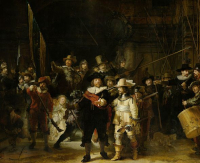 Night
wacht
Night
wacht Night
wacht Night
wacht |
Rembrandt van Rijn1606 - 1669 |
Table of contents |
References |
Contact us |
|
Starting from Rembrandt's drawings and etchings,
we propose to highlight his method to study and work with
the hope that it will benefit people who study and
practice drawing and engraving and more generally people
practicing an artistic creation activity.
In his documentary "Le mystère Picasso" (1955) (extract),
Henri-Georges Clouzot tries to penetrate the creative
process by filming Pablo Picasso drawing and painting. He
was trying to answer the question: what happens in the
brain of a creator when he is working?
We still have enough drawings and etchings by Rembrandt for us to be able to understand his method of studying and grasping a subject he wanted to tackle. Rembrandt had a very precise method to study and work. He was gifted with an extraordinary imagination and memory which enabled him to tackle a theme for several years without ever giving the impression of weariness. He had a great sense of humor, derision and was a provocateur. He was a work titan but above all a researcher, and thanks to these two qualities he was able to survive the material misery in which he found himself, the jealousy of his fellow painters from Amsterdam and the maliciousness of great number of his fellow citizens after the bankruptcy he had to face and the sale of his house and his press in 1658. For more than ten years, until his death in 1669, he kept on developing his research in painting.
Rembrandt
was first and foremost a free man and we will show how
this freedom is found in his drawing line and his way of
building his studies. He was a researcher who continuously
developed his engraving and painting techniques. He was
particularly attentive to the perception and
representation of the volume. All his research had the
unique purpose to translate and render the emotions of the
characters, animals, scenes or landscapes that he
represented. We propose to study how all of this can be
seen into the construction of his work. Rembrandt
had a very strong personality which is reflected in his
works and their observation allows to discover and
identify the features.
Finally, it should be noted that Rembrandt's works have a universal and timeless character which means that at any time they can be considered modern.
Jacques Roland
|